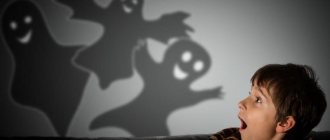Both in the distant past and in the present time, people experienced fear. Sometimes it has its own reason, it is completely natural, and sometimes it interferes with life and significantly harms health.
If the fear is far-fetched, of a pathological nature, then it is usually called a phobia - a much deeper condition that does not allow one to live fully. Phobias are accompanied by hallucinations, delusions, and cause nightmares and other destructive manifestations of the psyche. They can appear since childhood, and then transform and turn into other forms of fears.
Social fears
Social group refers to a person’s fears about his social position in society, existential ones are associated with the very nature of the individual, with his intellectual and spiritual qualities.
Social fears are associated with a person’s fear of losing his status in the eyes of society; the individual is afraid of a decrease in self-esteem.
Social fears are associated with a person’s fear of losing his status in the eyes of society; the individual is afraid of a decrease in self-esteem.
A person is afraid to take responsibility, avoids social contacts and obligations, and is afraid to go out in public.
What's behind fear?
Addition and comments from Arina Nikitina ⇒ What is behind fear. The house of pain in the concept of our ancestors. ⇒ The meaning of the word “Education” and its influence on a person. ⇒ The influence of parents on the formation of fears in children. ⇒ The influence of fears and beliefs on a person’s life. ⇒ Formation of a person’s personality. ⇒ Classification of fears in the tradition of our ancestors. ⇒ How to overcome childhood fears. ⇒ What can be understood about family relationships through a child’s toys. ⇒ Fears and psychosomatics.
What lies behind fear. The instinct of self-preservation
There is an opinion when they say that fear is a manifestation of the instinct of self-preservation. My experience and practice suggest the opposite. The instinct of self-preservation is activated and triggered only in cases of a real threat to life and is essentially a sense of danger.
When, at a moment of danger, the instinct of self-preservation is triggered, a person always takes the action that saves his life. When you need to jump 3 meters - it jumps away, you need to fly up a tree in a second - it takes off, it is important to freeze to save your life - it freezes, and so on. Those. It doesn’t matter whether a person thinks or doesn’t think at that moment, he is always under the influence of the instinct of self-preservation and does what ultimately saves his life.
If, at the moment of danger, fear turns on, then most likely the person will do something that will lead to death, unless someone or something intervenes and saves.
At critical or dangerous moments in life, when a person is overcome by panic, he will always commit rash acts that aggravate the situation. This happens because it is controlled by fear, whose task is to destroy. The only way out in such cases is to take control of your feelings, stop panicking, then the right solution will be found.
Who's the boss?
Those. It is very important to clearly learn to distinguish and understand where I control myself, and where I am controlled by fear. Who is the master of my life: fear or me? Who commands whom?
And further. Instinct is something that can be controlled because a normal person knows how to control his instincts.
Let us remember the exploits of soldiers and officers during military operations, when at the cost of their lives they saved the lives of others. Heroic deeds of modern firefighters and rescuers. These people in those moments are led forward by Spirit, Will and, oddly enough, Love for Life. This does not mean that they have no fear at all, it means that they were able to overcome it, defeat it, take control of it.
Freedom is awareness
It is important to recognize that in almost every living person there are certain types of fears, some are simply aware of them, others are not. Some people think that if they do not experience fear and fright, then there are no fears. The fact of the matter is that the real and strongest fears are not manifested by feelings, and they can only be tracked by analyzing one’s own actions and behavior.
Each type of fear has its own methods of working. They have one thing in common - in order to overcome any fear, it is important to recognize its presence and turn on awareness. Take control into your own hands and don’t let fear manipulate you, no matter what explanations and justifications it offers.
Remember, any fear is a great manipulator. He always justifies his presence by saying that he protects you from pain, suffering, misfortune and misfortune. In fact, he is lying, because with his appearance it becomes much more painful to live, there is also more suffering, it just goes to another level.
Fear always lies and forces you to do what it needs, deceiving a person, tricking him, sending him into confusion and distorting the perception of people, events and reality in general.
Existential fear
Existential fear is inherent in every person, this feeling is inside us, in the subconscious. There are no visible reasons for the emergence of such fears; they manifest themselves reflexively.
These include such human emotions as fear of death, fear of passing time and other abstract fears that evoke emotions and force one to reflect on eternal questions.
A strong negative emotion, in addition to the three main groups, also has intermediate forms that can be classified into different categories of fear.
For example, fear associated with health, with illness. It can be classified as a biological group, since we are talking about a person’s life, but it can also be classified as a social group, because a sick person is no longer able to work and do everyday activities.
An illness can leave an individual without work, which means there will be no money, poverty threatens, and social status will suffer. Fear of illness stands on the border of the biological and social groups of fears.
If we look at fear for our loved ones, it stands on the border of the biological and existential groups. At the same border there is a fear of a body of water or swimming: a person fears for his life, and we also have a fear of the element of water. It must be said that in any phobia you can find signs of all three groups, but one group will always dominate.
It has always been human nature to be afraid of predators, natural phenomena, and individual situations. Fears are transmitted to us by genetics and are stored at the reflex level. The negative experience of previous generations does not allow one to get rid of such phobias; they manifest themselves contrary to logic, but the mind does not allow one to relax. Some fears have already lost their relevance, but have not left our subconscious; they arise at the wrong time and interfere with life.
If we look at them as an example, we see the following picture: fear of snakes can be justified, there are poisonous specimens, but being afraid of small spiders and cockroaches is stupid.
Lightning strikes a person - fear is justified, but to be afraid of thunder, which thunders and does not make an attempt on life, is simply ridiculous. These phobias are with us all the time and continue to spoil our existence; people need to get rid of some of their reflexes.
The most common phobias
A phobia is a manifestation of irrational fear or increased anxiety associated with real or expected objects or situations that cause fear. This is an obsessive state that worsens under specific conditions and cannot be explained logically. Under the influence of a phobia, a person is afraid and tries to avoid certain situations, activities or objects.
Below is a list of the most common phobias in alphabetical order:
- Agoraphobia is the fear of open spaces. People with this fear prefer to always be indoors.
- Aquaphobia is the fear of water. In its hypertrophied form, it can develop into a fear of drinking even a sip of water.
- Acrophobia – fear of heights. Fear causes climbing to any heights, from a stool to mountains.
- Arachnophobia is the fear of spiders. It is considered characteristic of most people in the world.
- Astraphobia is the fear of thunder and lightning. A very common fear that causes people to take shelter during a thunderstorm.
- Aerophobia is the fear of flying and aircraft. It is a hindrance for many people who want to travel.
- Hemophobia is the fear of the sight of blood. At the sight of blood, even on TV, a person with such a phobia may lose consciousness.
- Gerontophobia is the fear of old age. Most often, this fear is observed in middle-aged people.
- Homophobia is fear, or rather rejection, of homosexuality and people with non-traditional sexual orientation.
- Dentophobia is the fear of dentists. People with this phobia would rather endure severe toothache than sit in the dentist's chair.
- Kacorrhaphiophobia is the fear of failure. Characteristic mainly of people focused exclusively on success.
- Cynophobia – fear of dogs. Another type of phobia that is common to a huge number of people.
- Claustrophobia is the fear of closed spaces. A person with an aggravated form of this phobia begins to panic in an ordinary elevator.
- Xenophobia is the fear of strangers. It can develop on sexual, interracial and religious grounds.
- Mysophobia is the fear of germs and dirt. A person with this fear is uncomfortable touching any objects outside his home, where there is always perfect cleanliness.
- Monophobia is the fear of loneliness. It can be expressed as a fear of being abandoned by a loved one, being alone in the world, or being alone in a room.
- Necrophobia is the fear of the dead. A clear example of fear of the unknown.
- Nyctophobia is the fear of the dark. Despite the fact that it mainly affects children, it is also observed in a huge number of adults.
- Ophidiophobia is the fear of snakes. Another example of a common fear. It is a subtype of hypertophobia - fear of reptiles.
- Social phobia is the fear of public attention. This can even include the fear of appearing in public places.
- Thanatophobia is the fear of death. This fear paralyzes a person’s will and prevents him from living a normal life.
- Trypanophobia – fear of needles, pricks and injections. A regular vaccination becomes a test of strength for people with this phobia.
- Trypophobia is the fear of open wounds and any holes in the skin, both on one’s own and on the skin of any living organism in general.
We, of course, could list a dozen other common phobias, but if you wish, you can do your own little research, for example, read what people are afraid of on the Internet. And we will add some zest to our article and briefly list some of the strangest phobias found in the modern world:
- agmenophobia – fear that the queue a person is standing in will move slower than the one next to it;
- acribophobia - fear of not understanding the essence of what you read;
- hapotophobia – fear of being touched;
- hexakosioyhexekontahexaphobia – fear of the number “666”;
- genophobia – fear of intimacy;
- hippopotomonstrosesquipedalophobia – fear of long words;
- dextrophobia – fear of objects located on the right;
- decidophobia – fear of making decisions;
- Domatophobia – fear of houses and any buildings;
- dorophobia – fear of giving and receiving gifts;
- Ignorophobia – fear of not receiving a response to a message you read;
- Imojiphobia – fear of being misunderstood after sending an emoticon or sticker;
- cyberphobia – fear of computers;
- kumpunophobia – fear of buttons;
- Lacanophobia – fear of vegetables;
- macrophobia – fear of long waits;
- nephophobia – fear of clouds;
- nomophobia – fear of being without a smartphone;
- omphalophobia – fear of belly buttons;
- Papaphobia – fear of the Pope;
- penteraphobia - fear of mother-in-law;
- Pogonophobia – fear of beards;
- punctumophobia – fear of messages with a period at the end;
- reterophobia – fear of making a mistake in a word or not seeing an erroneous autocorrect;
- Selfiphobia – fear of taking a poor-quality selfie;
- social network phobia – fear of social networks;
- philophobia - fear of falling in love;
- Chairophobia – fear of laughing in inappropriate conditions;
- Chorophobia – fear of dancing;
- chronophobia – fear of time;
- epistemophobia – fear of gaining knowledge;
- Ergophobia – fear of any work.
And this list of phobias does not exhaust the topic, which suggests that it is possible to find some kind of fear, even in a mild form, in almost any person in the world. Moreover, with the passage of time and changes in the specifics of each era, new, sometimes completely absurd, fears appear.
Of course, we sincerely hope that no fears or phobias cause you discomfort in life. If this is still not the case, read our article “Fear. What should you do with him?” in order to better know your enemy and overcome him. However, getting acquainted with this article is useful and simply for general development.
We wish you good luck and successful work on yourself, no matter what it concerns!
We also recommend reading:
- Storytelling
- Interesting and unusual facts about fear
- Overcoming Fear
- Some fears of modern man
- How to overcome the fear of a white page
- How to work with fears?
- Psychology of fear
- "Hot ten" human fears. How to deal with fears?
- Fear: psychological foundations and famous scientific studies of this phenomenon
- What is fear and how to overcome it
- Systematic desensitization method to combat fears
Key words:1Psychoregulation
How to overcome panic fear
The meaning of the word panic from Greek is “sudden”, “senseless”. Hence - panic fear - something like a phobia, which was initially in the form of fear, but then grew into a strongly reinforced feeling of fear.
If natural - mobilizes a person’s abilities, during which it becomes easier to avoid some unpleasant or harmful processes, then panic, in turn, suppresses the state of the psyche. A decrease in capacity can be caused due to a discrepancy between the conditions of reaction to a particular situation. As a rule, sensitive individuals are subject to panic fear.
Scary stories give rise to fear of heights, childbirth, death, etc. I work in fear rooms in such a way that the unknown is often frightening. Anything can happen in the unknown, and especially impressionable people can even get a heart break (one of the extreme cases).
In this regard, neuroses may arise, which lead to a series of somatic symptoms, such as suffocation, rush of blood to the head, chest pain, until loss of consciousness. Sleep disturbances and persistent nightmares and insomnia may begin.
Sudden panic fear complicates life and can appear completely unexpectedly.
If the process is started and it turns into panic, then the root of the problem should be sought immediately. But, if a person cannot overcome it on his own, which can be extremely difficult, then he should contact a specialist.
Neurotic symptoms are treated with both psychotropic drugs and psychotherapy.
The first method comes down to taking benzodiazepines, which are the most effective. The process of using them should be short-lived, as this can lead to addiction and complications.
The second method is based on psychotherapist sessions and long-term psychoanalysis, which can help both the patient and the doctor deal with the problem. Sometimes both methods go hand in hand to solve a problem faster.
This means that if panic takes hold of you from time to time, then you should immediately solve this problem, as this can lead to a number of somatic symptoms that not only reduce capacity, but also suppress a person’s mental health.
"Star" phobias
Celebrities are no less likely, if not more likely, than ordinary people to be afraid. Fear of something can reach the point of absurdity. Let's consider what fears stars have.
- Nicole Kidman experiences wild horror at the sight of butterflies. Interestingly, cockroaches and mice do not evoke any emotions in the star.
- Uma Thurman suffers from claustrophobia, which she developed after filming a film where she had to lie in a coffin. Now the actress is afraid of elevators and enclosed spaces.
- Orlando Bloom is famous for his fear of pigs. His pathology also developed as a result of filming the film. The big boar escaped from the cage and rushed after the actor.
- Oprah Winfrey can't stand chewing gum. Her fear comes from childhood, when her grandmother frightened her as a little girl with punishment at school for chewing. The fear turned out to be so strong that it haunts the celebrity to this day.
- Scarlett Johansson is terribly afraid of birds. The actress developed a fear of birds as a result of filming the film “We Bought a Zoo,” during which a peacock broke free, thereby frightening the star.
People's fears are endless, and celebrities are no exception. You can live peacefully with many of them, while some are very poisonous and require specialized help.
Treatment of fears
To treat fear, a specialist diagnosis should be performed. From the above, we can conclude that it is divided into congenital and acquired. If the problem is not natural, but social or existential fear, then it can be eliminated using several methods.
Ways to eliminate it:
- Psychotropic drugs
- Psychotherapy (specialist help)
- Breathing techniques
- Imagination control
- Meditation and other practices
- Face your fear
The first method is most often used for neuroses, the affect of fear (with strong excitement and loss of self-control). Such cases are extreme, so treatment should be immediate.
Psychotherapy is used for the ability to understand and recognize one’s fears, the concept of their original source and eradicate them in the future.
It is important to maintain deep breathing to calm yourself down. It is rapid breathing that precedes fear, so bringing it into the right direction will help you calm down.
“7/11 Technique” is called that because of the score. Its essence is this: take a deep breath, counting to seven, and exhale deeply, counting to 11. It is not necessary to use these exact numbers, the main goal is to increase the time for exhalation, in comparison with inhalation.
The first thing that gives rise to fears is the limitless possibilities of our imagination. On the one hand, its immense possibilities can benefit people of certain professions, but on the other hand, their reinforcement comes precisely from these same opportunities.
Controlling the imagination is the path to exploring oneself and understanding whether what it seems is as scary as it seems. Of course, it is impossible to completely control your thoughts, but you can limit their negative flow by surrounding yourself with positive information and limiting access to negative information.
Meditation is a more extensive practice than controlling the imagination and is one of the auxiliary techniques for achieving this goal.
The Austrian psychologist and psychiatrist Viktor Frankl proposed a direct meeting with them as a treatment. Fear of closed spaces means you need to be there more often, arachnophobia means holding a spider and repeating the procedure several times. Of course, all this should happen gradually and under the supervision of a specialist with his recommendations, but this should already give positive results the second and third time.
How to overcome feelings of fear
Fear itself is an unpleasant feeling that takes away excess energy. To understand how to deal with it, you need to determine its original source.
If the nature of fear is sudden in a certain situation, and does not accompany you constantly (fear of heights or darkness, fear during childbirth), then there are certain ways to eliminate or neutralize it for a while.
Psychologists often recommend getting rid of the negativity around you by limiting the following information:
- Unsubscribe from negative mailings, channels and groups (on social networks, etc.)
- Limit your ability to communicate with people who fuel it (if there are any).
- Try to eradicate bad thoughts in the bud. As soon as they are born, drive them away.
- Try to read more positive information.
- Keep conversations about good things with your interlocutors.
- Surround yourself only with good emotions, pleasant words, and kind deeds.
Observe fear to understand what it does to your body at that fateful moment. Consider its negative impact on your body and accept the fact that it is bothering you.
Try to act as if you are not afraid. Feel this for yourself and think about which position you look more advantageous in: the first or the second. Try to convince yourself that there is no reason for fear, it was once invented by your imagination. Tune in to positive emotions and believe that the steps listed above will help you in the fight against it.
Remember what fears you were able to overcome earlier in order to feel the positive emotions that you experienced. Realize their significance in your life, because every step to fight it is an approach to a small victory
Fighting it by directly interacting with it will be much more successful than trying to escape from your thoughts. The more we run from ourselves, the more phobias can overtake us.
Classification of fears
There is not a single person in the world who is not afraid of anything. And this is normal: the emotion of fear is genetically determined and performs a protective function. There are a huge number of different fears, so there was a need to classify them. Each classification of insurance has its own advantages and disadvantages. Classification of fears according to Sigmund Freud
is quite simple, it includes only two groups: real fears and neurotic ones.
Real fear
is a completely normal emotional process.
It occurs in a situation of danger and helps the body mobilize to avoid this danger. And neurotic fear
is what we are used to calling a phobia; it occurs when confronted with situations and objects that are not actually dangerous.
Following Freud, other scientists began to divide fears into two groups. Let's say there is a classification of fears into constructive
and
inadequate (pathological)
. An important conclusion can be drawn from this: not every fear is a phobia, as some people think. In a situation of danger, fear is normal and even useful, because it ensures self-preservation.
But an unfounded phobia is already a mental disorder
that needs to be fought. ICD-10 (International Classification of Diseases), for example, classifies phobias in class V (mental and behavioral disorders), a block of neurotic, stress-related and somatophoric disorders. This block includes, for example, obsessive-compulsive disorder and neurasthenia. Phobias are classified by subject, say, anthropophobia - fear of people, insectophobia - fear of insects, etc.
The line between fear and phobia can be quite thin
. For example, in an area where poisonous spiders are found, the fear of spiders is well founded, because there is a real danger of being stung. But in those geographical regions where the chances of meeting a poisonous spider tend to zero, the fear of spiders becomes a phobia, especially if a person is afraid not only of poisonous spiders, but of everyone in a row.
There is also a classification of fears by Professor Yu. V. Shcherbatykh. He divides all fears into three main groups. Biological fears
directly related to the threat to human life (for example, fear of fire).
Social fears
are associated with fear of changing social status (fear of losing a job, fear of public speaking).
Finally, existential fears
are associated with the very essence of a person (fear of death, fear of open and closed spaces, fear of heights).
Some fears may be at the intersection of two categories.
. Let's say, the fear of illness, on the one hand, has a biological nature, because illness is accompanied by pain and suffering. On the other hand, it is a social fear, because the disease leads to forced withdrawal from normal activities and isolation. And the fear of losing loved ones is both existential (fear of inevitable death) and social (close people are part of the environment, when they change, our social status changes).
Psychotherapist and psychiatrist B. D. Karvasarsky proposed a classification of fears according to the “plot of fear”
. He divided fears into eight groups. The first group is existential fear of space (claustrophobia, agoraphobia, acrophobia). The second group is social phobia (social fears). The third group is fears of diseases (nosophobia). The fourth is the fear of death (thanatophobia). The fifth includes fears related to the sexual sphere. Sixth, fear of harming loved ones and oneself. The seventh group is “contrasting” fears (for example, the fear of committing an indecent act in society). The eighth group is fear of fear (phobophobia).
There is more than one classification of fears according to various criteria.
: fears of children and adults (or children and parents), existential and everyday... And existential fears, for example, can be divided into fear of time, fear of space, fear of oneself and fear of the unknown of life. You can continue almost indefinitely, because the list of human fears is very long.
Why is classification of fears needed at all? It is very important to be able to separate reasonable fear, which in a critical situation can even save a life, from phobia, which only poisons our existence. Fears need to be dosed, and phobias need to be fought
. And for a successful fight, you need to know the enemy by sight.
Related publications:
Psychology of fear
For centuries, the feeling of fear has caused confusion in people. The problem received a lot of attention from both religion and philosophy; painters and sculptors tried to assess the situation. With the advent of psychology in the 19th century, the phenomenon began to be viewed from a scientific point of view. Fear was an internal state caused by a state of real or imaginary threat. When a person perceives a situation as dangerous, the body gives a signal. Attitudes to the outside world and phobias are individual, and experts talk about hundreds of their varieties.
If they are exposed to humans, they also develop physical symptoms. Severe blushing, sweating, stuttering, dizziness combined with blackouts and tremors, even difficulty breathing, palpitations, stomach pain, nausea, even a real panic attack may occur.
Treatment options for social phobia. Cognitive behavioral therapy has been particularly effective in treating social phobia. The therapist works on a cognitive level with their client and helps them analyze and reduce their negative thinking patterns to gain a more realistic picture and create a more resilient self-esteem. Life cards are a very useful tool because they are effective in these areas - positive affirmations, self-improvement and self-confidence.
What are the fears?
For convenience, we will sort phobias/fears alphabetically. The tables provide a list of all human phobias.
A
| Name of fear | What is a person afraid of? |
| Ablutophobia | Swim |
| Aviation phobia | Fly by the plane |
| Agoraphobia | Large open spaces, squares |
| Aquaphobia | Water |
| Acrophobia | Feeling afraid of heights |
| Alginophobia | Pain |
| Amnesiphobia | Lose your memory |
| Androphobia | Fear of men and intimacy with them |
| Ankylophobia | Fear occurs when thinking about immobility |
| Anthophobia | Anxiety or panic at the sight of flowers |
| Asthenophobia | Weaknesses |
| Atazagoraphobia | Forget something |
| Autophobia | To be left without a spouse |
| Automysophobia | Get dirty |
B
| Ballistophobia | Pul |
| Bathophobia | Locations in multi-storey buildings |
| Bibliophobia | Libraries |
| Blatophobia | Beetles and cockroaches |
| Bogiphobia | Everything otherworldly and mystical |
IN
| Vaccinophobia | Vaccines |
| Venerophobia | Venereal diseases |
| Vertigophobia | Dizziness |
| Wiccaphobia | Magic, witchcraft rituals and everything connected with them |
| Vinophobia | Wine drinks and their use |
| Virginityphobia | Rape |
G
| Gamaxophobia | Transport on wheels |
| Gamophobia | Bonds of marriage (women's marriage, men's marriage |
| Gatophobia | Cats (domestic only) |
| Hedonophobia | Pleasant sensations, joyful feeling |
| Hematophobia | Blood (panic so severe that the person may lose consciousness) |
| Gerascophobia | Old age |
| Herpetophobia | Serpent |
| Heterophobia | Representatives of the opposite sex |
| Hydrargiophobia | Substances containing mercury |
| Hylophobia | wooded area |
| Hypegiaphobia | Responsibility for something |
| Hypnophobia | Hypnosis |
| Hippophobia | Horses |
| Gnosiophobia | New knowledge |
| Hodophobia | Panic fear of traveling |
| Homophobia | Manifests itself in fear (even hatred) of homosexuals |
| Gravidophobia | Pregnancy and pregnant women |
D
| Dementophobia | Lose my mind |
| Demonophobia | Otherworldly evil spirits |
| Dentophobia | Dental procedures |
| Decidophobia | Making independent decisions |
| Diabetophobia | Diabetes mellitus |
| Dikephobia | Justice |
| Dysmorphorbia | Your appearance |
| Dorophobia | Give something |
E
| Euresiphobia | Ideas that do not coincide with public opinion |
| Eupophobia | Positive news |
Z
| Zeusophobia | Panic at the thought of deity |
| Zoophobia | General name for fear of animals, which is divided into many varieties |
AND
| Iatrophobia | Medical institutions |
| Isopterophobia | Insects |
| Intimofia | Sexual intimacy (especially the first) |
| Iophobia | Get poisoned by poisons |
| Hypochondria | Any illness |
| Ichthyophobia | Fear of fish |
TO
| Kairophobia | Everything new (people, things, events) |
| Cacophobia | Blows, beatings |
| Cancerophobia | Get sick with cancer |
| Cardiophobia | Cardiovascular diseases |
| Keirophobia | Injuries during hairdressing procedures |
| Kinophobia | Dogs |
| Kyphophobia | Slouching, hunch on the back |
| Claustrophobia | Panic fear of enclosed spaces |
| Cleisiophobia | Thieves, robberies |
| Cnidophobia | Fear and aversion to all varieties of insects |
| Koinophobia | Fear of crowded rooms |
| Coimetrophobia | Panic at the sight of cemeteries |
| Cometophobia | Space objects and events |
| Countertophobia | Harassment |
| Copophobia | Loss of strength |
| Spacephobia | Space objects |
| Cryophobia | Cold |
| Xerophobia | Dry weather |
| Xyrophobia | Shaving machines |
| Kumpunophobia | A very rare pathology that manifests itself as panic at the sight of buttons |
| Khorophobia | Dance |
L
| Laliophobia | Talk |
| Lachanophobia | Eat vegetables |
| Leukophobia | White |
| Ligrophobia | darkness |
| Lissophobia | Development of mental disorders |
| Louisphobia | Get sick with syphilis |
| Lutraphobia | Otters |
M
| Macrophobia | Waiting (especially long) |
| Maleusiophobia | Give birth to |
| Megalophobia | Volumetric objects |
| Honeyphobia | Jellyfish |
| Mesophobia | Infectious pathologies |
| Meningitophobia | Development of brain diseases |
| Methylophobia | Alcoholic drinks |
| Mechanophobia | Road transport |
| Microphobia | Small items |
| Morphinophobia | Morphine addiction |
| Musophobia | Mice |
N
| Necrophobia | Funeral rites, corpses |
| Neophobia | Everything new |
| Nosocomephobia | Medical institutions |
| Numerophobia | Numbers |
ABOUT
| Obesophobia | Overweight |
| Oikophobia | Lose my mind |
| Olfactophobia | Smells |
| Oocytophobia | eggs |
| Ornithophobia | Birds |
P
| Papyrophobia | Fear of paper, paper objects |
| Paralipophobia | Take a wrong action |
| Parapophobia | Doing your duty |
| Parthenophobia | Virgins |
| Patroyophobia | Diseases transmitted by inheritance |
| Peiraphobia | To speak, to give a speech in front of an audience |
| Pyrophobia | Fire |
| Plakophobia | Mogil |
| Potilitikophobia | Politicians |
| Proctophobia | Development of proctitis |
| Psychophobia | Mentally ill people |
| Pteronophobia | Bird feathers |
R
| Radiophobia | Radiation influence |
| Ritiphobia | Appearance of wrinkles |
| Russophobia | Total Russian |
WITH
| Selaphobia | Sveta |
| Silensophobia | Silence |
| Sinophobia | Total Chinese |
| Sitiophobia | Eat food |
| Scotomaphobia | Blindness |
| Sophophobia | Learn something new |
| Social phobia | Being in society |
| Speedophobia | AIDS |
| Staurophobia | Krestov |
| Stenophobia | Too narrow rooms |
| Suicidophobia | Committing suicide |
T
| Thalassophobia | Large expanse of water (sea, ocean) |
| Thanatophobia | End of life |
| Taphephobia | Buried alive |
| Teniophobia | Worm infections |
| Thermophobia | Heat, high temperature |
| Tomophobia | Wild horror before surgery |
| Traumatophobia | Damage, wounds, traumatic situations |
| Tredecaphobia | Numbers 13 |
| Tuberculosisphobia | Infection and development of tuberculosis |
U
| Uranophobia | Raya |
| Urinophobia | Perform the process of urination |
X
| Chairophobia | Pleasant, joyful feelings |
| Hoplophobia | Knives and other sharp objects |
C
| Cenophobia | Empty rooms, empty space |
| Cyclophobia | Bicycle transport |
E
| Eichophobia | Best wishes, good luck |
| Eleuterophobia | Freedom (to the point of disgust) |
| Electrophobia | Sockets, electricity |
| Enissophobia | Critics addressed to you |
| Enosiophobia | Committing a sin |
| Ercinophobia | Incomprehensible works |
| Ephebiophobia | Teenagers |
I
| Jatrophobia | Medical personnel |
These tables provide lists and meanings of common phobias. But in fact, there are much more of them, which once again proves the prevalence of mental illnesses in our time.











